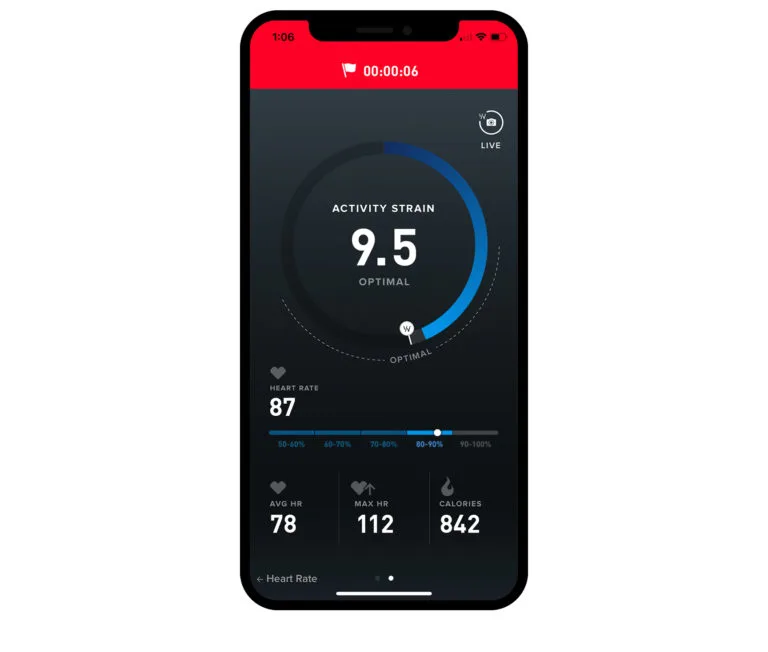Topics
- Article
- Heart Rate
- Running
What is a Good Running Heart Rate?

Your running heart rate varies depending on the type of run. Using heart rate zone training in conjunction with run training helps you recover faster and be prepared for race day.
Your heart rate increases during any physical activity, including running. That makes it a good measure of how much you are pushing yourself during exercise to reach your fitness goals. Monitoring your heart rate during running can help you maintain your intensity while keeping it in a safe zone. Below we’ll get into the benefits of heart rate run training, measuring your ideal heart rate, safe heart rate limits, and monitoring your heart rate while running with WHOOP.
Using your heart rate zones
Strain is a function of your max heart rate and the amount of time you spend in different heart rate zones, the more time spent in elevated heart rates, the higher your Strain. WHOOP uses the heart rate reserve method, which takes into account your max heart rate and resting heart rate over the last 14 recoveries to give you more accurate and personalized HR zones, so as you make progress your HR zones will reflect that.
You can also manually adjust your HR zones to further personalize your experience.
To adjust Max HR & HR Zones
Tap More > App Settings > Activity Settings > Heart Rate Settings
Heart Rate Training vs. Pace Training
Both heart rate training and pace training have their benefits for preparing for a race. Pace training is tailored to a goal pace, so for example your plan may be to run a 9-minute mile to prepare to run a 5k race in 27 minutes. You may want to do a tempo run at a 9 minute mile and an easy run at 10:45. But, these goals don’t take into consideration poor recovery days, hot or humid weather, and other variables like heart rate training does. Both types of training can be used in conjunction to create a comprehensive run training plan that takes your body into consideration.
Benefits of Heart Rate Training
Heart rate training uses your heart beats per minute (bpm) as a guide to hitting running intensities instead of training at a specific pace. The goal of heart rate training is to push your aerobic system without overexerting yourself, reducing the risk of overtraining, fatigue, and injuries. The benefits of heart rate training include: Recovery: You’ll know how to pace your easy runs so you can recover more efficiently and be ready for your next hard run or race. Flexibility: Your resting heart rate can be 20% higher in hot weather, humidity, and at high altitude. Your typical Zone 2 pace may put your heart rate into Zone 3 or 4. Training at pace in these conditions could elevate your heart rate into a dangerous zone.
Running Heart Rate Zones are Based on Your Max Heart Rate
Your running heart rate zones are based on a percentage of your max heart rate. For example: a 35-year-old's moderate HR would be between 129-148 bpm.
The first step in using heart rate zone training for running is to figure out your max heart rate. You can calculate it using a formula such as the Tanaka or Gulati, or more simply subtract your age from 220. Using the latter method, a 35-year-old’s max heart rate is 185 bpm. Once you know your max heart rate, you can establish your heart rate training zones and start planning your runs based on the average heart rate you want to reach. Zone 1: 40-60% of your max heart rate. Your effort in Zone 1 will be very light, warm-ups or cool-downs as well as recovery runs. Zone 2: 60-70%. This is the zone you want to maintain for your weekly long run. You can hold a conversation if you run with a partner or in a group. Zone 3: 70-80%. This is a moderate pace, and your breathing is coming faster but still steady. It’s best for tempo runs, hills, and threshold training. You can still speak in complete sentences but holding a conversation might be difficult. Zone 4: 80-90%. This should be your racing pace for a 5k, as well as speed intervals and fartleks. You won’t be able to speak in sentences at this pace. Zone 5: 90-100%. In Zone 5 you’ll hit your max heart rate and your VO2 max–the maximum amount of oxygen your body can utilize during exercise. This is the zone you want to be in to finish your race or for shorter speed work like 200 and 400-meter sprints. In Zone 5 you probably won’t be able to speak. READ MORE: Marathoner Shares Four Runs She Uses for Training
Maintaining a Safe Running HR
The most important aspect of heart rate zone training is to maintain a safe heart rate during your run. In addition to your age and the weather, your running heart rate is influenced by: Fitness level: If you’re a runner or work out regularly, you’ll likely have a lower resting heart rate than a non-active person. Medication use: Beta blockers or thyroid medications may affect your normal heart rate. Stress: Your emotional state may quicken or slow your heart rate. Hitting your maximum heart rate for long periods of time can be dangerous to your health and may increase your risk of cardiac events, according to one study. For these reasons, you might want to slow your pace if you’re consistently reaching your max heart rate while running.
Track Your Heart Rate While Running with WHOOP Strain Target
Using a heart rate monitor is the easiest way to know your HR while running. The WHOOP Strain Target tracks your live heart rate and also lets you know which heart rate zone you’re in while exercising. Additionally, the Strain Target gives you recommendations for your daily exertion based on your recovery and strain you’ve already accumulated. When you start an activity, it shows your strain building in real time towards the suggested goal, as well as how many calories you’re burning. It enables you to better understand if you should continue to push yourself, or if you’re overdoing it, allowing you to make informed decisions in the moment.

The WHOOP Strain Target tracks your live HR data and lets you know which heart rate zone you're in at a glance.